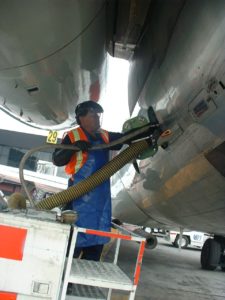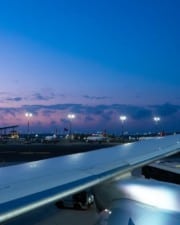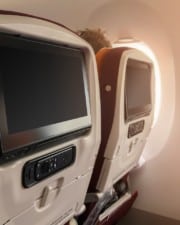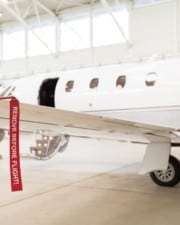There is little doubt in most people’s minds that the toilets on airplanes are different than other types of toilets. If you’re wondering how airplane toilets work, you’re not alone. Most people are curious about this and with good reason. Fortunately, the method used to collect waste from toilets on airplanes is a lot easier to understand than you think.
Table of Contents
How Do Airplane Toilets Work?
Instead of the water used in regular household toilets, an airplane toilet uses a vacuum system that essentially sucks things out of it and holds it in a special tank that is located on the airplane itself. Once the airplane lands, the waste that has been collected is moved by several specialized tankers and then discharged into a drainage system that is made specifically for this purpose.
How Do Airplane Toilets Collect Waste?
It really isn’t that complicated of a process. The waste goes into the toilet, then gets sucked into a special tank that is normally located in the back of the airplane.
When you land, special trucks with yet more tanks come and use hoses to suck the waste from the airplane to their own holding tanks.
Then the waste goes into another tank that is usually a part of the airport, where it is mixed in and eliminated along with other waste found in airport toilets.
First Things First
To understand how an airplane toilet works, you have to first be familiar with how a regular toilet works. Standard toilets use water and gravity to work. When you flush the toilet, the water siphons the waste, then uses gravity to pull it into a sewer system or septic tank. Unfortunately, this is impractical on an airplane because there is no septic system to hold the waste.

You cannot use the siphon effect or gravity on an airplane because placing water into the toilets there doesn’t work. Each time the airplane moves, the water would splash about and make a mess, which is why airplanes cannot use a standard toilet. On an airplane, the vacuum system — not the siphoning motion — does all the work and there is only a tiny amount of water to clean the bowl and get it ready for the next person.
With standard toilets, roughly half a gallon of water is used each time that you flush but an older toilet can use up to five gallons per flush. In an airplane toilet, much less water is used. These toilets also offer the following advantages:
- They can be placed anywhere on the airplane.
- They can flush in many different directions.
- They use pipes that are very small in diameter and can therefore go anywhere.
- The pipes do not necessarily have to be placed facing downward so they can save space.
- They are lightweight and easily installed.
What Happens When You Flush an Airplane Toilet?
Airplane toilets usually have a blue liquid added to the small amount of water they use but this is a cleaning liquid only and has no effect on the way the toilet works or how it flushes. When you flush the toilet, the vacuum effect is utilized and all of the toilet’s contents, including the blue water, is trapped within a special tank or closed waste system. If you’ve ever wondered how airplanes dispose of toilet waste, now you know.

Contrary to what many people believe, the flight captain has no special button that can be pressed to detach the toilet tank and send it flying through the air.
In other words, you never have to wonder, do airplanes release waste in the air, because they do not. Instead, the waste is held in the closed waste system until the plane lands. A truck comes and suctions the waste from the plane into another tank located in the back of the truck, where the waste is then disposed of along with the waste from the rest of the airport.
Toilets in The Early Days of Aviation
Before the mid-1970s, passengers did their business in a slosh bucket or bottle, which never had to be flushed and just sat there in the toilet until the plane landed. Around 1975, a man named James Kemper invented the airplane toilet that people are familiar with today and it began being used in 1982 in a Boeing airplane.
Today, airplane toilet bowls are nonstick and contain a small amount of water and blue liquid called Skykem, made with the same main ingredient found in “blue ice.” This liquid is used to disinfect the bowl and kill any odors lurking about in the bathroom. The loud noise you hear when you flush a toilet on an airplane actually comes from the sucking or vacuum system, not the waste materials being hurled into the air.
The trucks used to suction out the waste from the plane use special hoses to do the job and the airplane’s tanks are always cleaned and disinfected afterwards. Not only do pilots not clear the toilet tanks during a flight but they are actually unable to do so. Not only that, it is illegal to do so.

There is also no validity to the stories regarding people’s insides getting sucked out while sitting on an airplane toilet. This has quite literally never happened. Being disemboweled while sitting on an airplane toilet and then flushing it is not going to happen because your bottom section would have to create a vacuum effect within the toilet. This cannot happen since the toilet seat itself prevents this vacuum effect.
What About Blue Ice Falling from the Sky?
Unfortunately, there are credible reports of large sections of blue ice landing on people’s decks and homes, although they are extremely rare. This “blue ice” is a mixture of Skykem and human waste. It freezes once the plane gets in high altitudes and then leaks out of the plane’s undercarriage. It dislodges once the plane is close to landing because the temperature warms up at this point.
Again, this is a very rare occurrence so the average person doesn’t have to worry about human waste from airplanes falling on his or her home or patio. It simply doesn’t happen often enough to sit around and worry about it.
The Future of Aircraft Lavatories
When it comes to airplane toilets, the future looks as if it may offer even better models. After all, it’s been 30-something years since the last great invention came along so the world is ready for something better. In 2016, a prototype of a new type of airplane toilet was developed by Boeing. It offers a larger type of airplane commode and a way to clean itself after each use.

To accomplish this, ultraviolet light is released on the lavatory for a total of three seconds; in this short period of time, 99.99% of pathogens are eliminated. The lights are also strategically placed in locations where they can hit vital spots around the bathroom including the countertops, toilet seat, and the faucet. In addition to sanitizing the bathroom, it also makes it smell a whole lot better.
Boeing is also working on several hands-free options for airplane bathrooms that will allow hands-free ways to use the soap and the faucet, place something in the trash can, and even lock the door after you get inside. These will make airplane bathrooms much easier to use, much cleaner and more sanitary, and much safer as well.
This way, you won’t have to deny yourself when you’re in the air and nature calls because the bathroom won’t be a place that you dread or fear.
Related Posts













